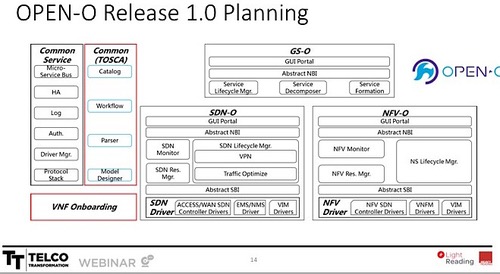|
|
|
Contributors | Messages | Polls | Resources |
|
OPEN-O: Cracking the OSS Quandary When it comes to migrating to new virtualized services and networks, most service providers are restrained by the ball and chain of their legacy OSS platforms. In order to reap the benefits of NFV, SDN and virtualization, there needs to be a way to interwork with legacy OSS, which is one of the primary goals of the OPEN Orchestrator Project (OPEN-O). "We know the legacy OSS is a challenge for the telecom SDN and NFV (implementations)," said Hui Deng, principal staff of Leading SDN/NFV Technical Strategy at China Mobile Research Institute, during Telco Transformation's webinar on OPEN-O. "To operate, you need to build a service, even for the new innovation services, that interconnects with all of your legacy systems in the SDN aspect or in the NFV part." By building a pathway to legacy OSS, service providers would have unified policies and unified quality of service assurance. For example, virtualized functions in the cloud need to connect with service providers' legacy infrastructures that are currently managed by legacy OSS, Deng said. Two other key design factors for OPEN-O, according to Deng, are helping operators that don't have a large stable of developers and phasing in hybrid network use cases. OPEN-O was designed to create an open source, unified orchestration platform for end-to-end service orchestration across both NFV and SDN network domains, but it also supports brownfield environments. OPEN-O's goal is to enable orchestration of any service over any network by leveraging a modular approach that can be integrated with multiple VNF managers, SDN controllers and VIMs. "One of the key differentiators for OPEN-O is that we will support brownfield environments," said Marc Cohn, vice president of network strategy at The Linux Foundation, during the Telco Transformation webinar. "Many operators have billions of dollars of equipment already installed and we want to make sure that as they move to the SDN and NFV future, we have support for the existing networks." The Linux Foundation first announced OPEN-O at Mobile World Congress in Barcelona earlier this year. The formalization of the OPEN-O project took place during a workshop in early June and was followed by the OPEN-O Mini Summit, in conjunction with the OPNFV Summit, in Berlin on June 21. (See OPEN-O Focused on Orchestrating SDN & NFV.) "We have 12 members who have formally joined the project," said Cohn, during the webinar. "Because of the phenomenal technical activities that took place between March of this year and June, we actually hit the ground running with organizations proposing over 100 developers." For its first release, OPEN-O has approved four targets: a Global Services Orchestrator, NFV-Orchestrator, SDN-Orchestrator and Common Services. The first release, which covers both residential and enterprise use cases, is scheduled to be finished by the end of the year.
"We don't want the operators to always be thinking about the infrastructure, but really about the new services and the new values that they can be bringing to their customers," said Christopher Donley, senior director of Telco Open Source Ecosystems at Huawei Technologies, during the webinar. Of course, OPEN-O isn't the only fish swimming in the open source sea. AT&T recently announced it had put its Enhanced Control, Orchestration, Management and Policy (ECOMP) platform into open source with the Linux Foundation. Open Source MANO (OSM), which is under the umbrella of European Telecommunications Standards Institute (ETSI) , was announced around the same time as OPEN-O earlier this year. (See AT&T's Rice: ECOMP Reaches Critical Mass and OSM Demos First Steps to Open Source MANO.) While Cohn, Deng and Donley didn't specifically talk about the differences between OPEN-O and other open source efforts, they did stress that it was designed to be an end-to-end orchestration solution. "So OPEN-O is end-to-end, meaning that it will support the connectivity services as well as the virtualization services all the way from the customer premises, all the way to the edge of the Internet," Donley said. "It's also model-driven and that is important to the operators as they want to deliver new services much faster than we have in the past." The OPEN-O webinar is available in on-demand mode on Telco Transformation. — Mike Robuck, Editor, Telco Transformation |
The winners from the holiday edition of Telco Transformation's caption contest are announced.
It's the final cartoon caption contest of the year for Telco Transformation.
Comcast and AT&T are among the first companies to pass out bonuses to employees after tax reform legislation passes.
Disney is upping its streaming video game with its deal with 21st Century Fox.
CenturyLink's survey also asked IT professionals about SD-WAN, Ethernet and MPLS.
 On-the-Air Thursdays Digital Audio On-the-Air Thursdays Digital AudioARCHIVED | December 7, 2017, 12pm EST
Orange has been one of the leading proponents of SDN and NFV. In this Telco Transformation radio show, Orange's John Isch provides some perspective on his company's NFV/SDN journey.
 Special Huawei Video Special Huawei VideoHuawei Network Transformation Seminar The adoption of virtualization technology and cloud architectures by telecom network operators is now well underway but there is still a long way to go before the transition to an era of Network Functions Cloudification (NFC) is complete. |
|
|
|
||



















